Photo Credit: tomekwalecki from Pixabay
To conform or not? It’s something Apple could face in the near future when the European Parliament makes a decision about USB-C.
The Decision
As said, the European Parliament is currently discussing the use of a universal charger port for smartphones. This will force Apple to move from their proprietary Lightning connector to the USB-C counterpart.
Apple’s History
Starting out with their 30-pin connector in 2007 and by moving to the Lightning connector in 2012 the company made waves in the Apple community. Suddenly, millions of perfectly working 30-pin cables would be thrown away with the purchase of an iPhone 5 or newer.
Apple moved from the 30-pin to the Lightning connector for a number of reasons, but the main reasons were speed and physical size.
European Parliament’s Stance
MEP’s want to limit electronic waste and promote the consumer’s experience, by forcing tech companies to use one universal port for charging and data transfer, USB-C. This will apply to smartphones, mobile phones, ebook readers, tablets and other portable devices.
The decision is only valid in countries that fall under the European Parliament. This means that only iPhones sold in Europe should comply with this law, but it would be inefficient for Apple to design and ship two different phones and cables, one to sell in Europe and another to the rest of the world.
Apple’s Defence
Arguing against the universal connector, Apple said they want innovation to thrive in the industry. If all smartphone makers have to have the same connector and cables, innovation is petrified.
Another colossal problem Apple foresees is the unparalleled volume of electronic waste. More than a staggering 1 billion devices made by Apple have shipped with the Lightning connector and cable. This includes Europeans by the millions.
Apple’s Confusing Argument
In 2019, Apple switched the iPad Pro from Lightning to USB-C, while other iPads were still shipping with the Lightning connector.
Other devices including the MacBook, MacBook Air, MacBook Pro and the new MacBook Pro 16″ also moved over to USB-C.
The question stands: why was there no major fuss about the iPad Pro having USB-C, but now Apple goes against USB-C for iPhone?
Impact on Consumers
Should you want two or more original (yes, it is the best practice) charging cables for your iPhone or other devices, one for home and one for work, and some even have a third for travelling in the car, you will need to buy brand new ones. These cables can get quite expensive.
A 1m USB-A to Lightning cable will set you back R399 at Digicape and iStore and $19 on Apple.com.
Now you will also travel with two different cables, the Lightning for your old devices and the USB-C for the new ones. More cables, more cables to lose or damage.
iPhone
Rumours are circulating that Apple will move away from the Lightning connector in the upcoming iPhone 12 anyway, but another rumour claims that Apple is researching an iPhone that has no ports and will only use wireless charging.
Closing
I don’t know which connector you would prefer on your next iPhone. USB-C does make life easier by charging everything with one cable, but on the other hand, the Lightning connector makes the iPhone feel exclusive.




